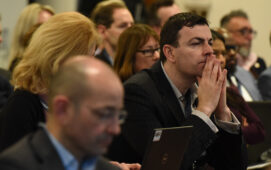One of the most notable things about this year’s Sibos, on both the exhibition floor and in the sessions, was the prevalence of mobile technology. Many of the vendors and banks in attendance were touting their new apps to bring the middle and back office into the 21st century. Whether it was the ability to engage in proxy voting for corporate actions or to take action on processing exceptions for risk management purposes, mobile technology was the order of the day.
Up until now, the focus has seemingly been on the front office application of this technology, with vendors from this world offering trading applications or low latency market data available from Apple iPads or similar mobile devices. However, given by the sheer number of delegates carrying around iPads (seemingly they are the new must have accessory for the exec away from the office), the middle office and back office has been quick to catch up.
Vendors servicing this market have been quick to capitalise on the opportunity presented to them: just look at XSP’s new Go! (exclamation mark courtesy of the vendor, not me) solution, which purports to bring the processing of corporate actions responses and elections to the world of mobile devices or Information Mosaic’s IMConnecting solution, which provides customer reporting and communication tools over the iPad or similar. According to Grace O’Donnell, deputy CEO of Information Mosaic, who demonstrated the solution on an iPad to me on the show floor, the technology lends itself to being applied to areas such as corporate actions, proxy voting and the analysis and valuation of portfolios for custody purposes.
A number of banks have also jumped on the mobile device bandwagon to reach out to and respond to their clients in a more proactive manner. Everyone’s at it.
Moreover, Swift itself attempted to take advantage of the proliferation of mobile technologies in the audience by encouraging delegates to tweet questions to moderators (rather than facing the embarrassment of raising a hand to ask a question, which is obviously far too labour intensive). Those that failed to make it along to the conference itself were also able to monitor the countless tweets going out from the Swift staff and journos in attendance to catch up in real time with what they were missing.
All of this begs the question, what will we see at Sibos next year? Perhaps, rather than flying so many speakers out from around the world and raising its carbon footprint, Swift will opt to video conference in panellists? After all, it you can’t ask them a question whilst they’re in the room, why can’t they be thousands of miles away?
Subscribe to our newsletter




